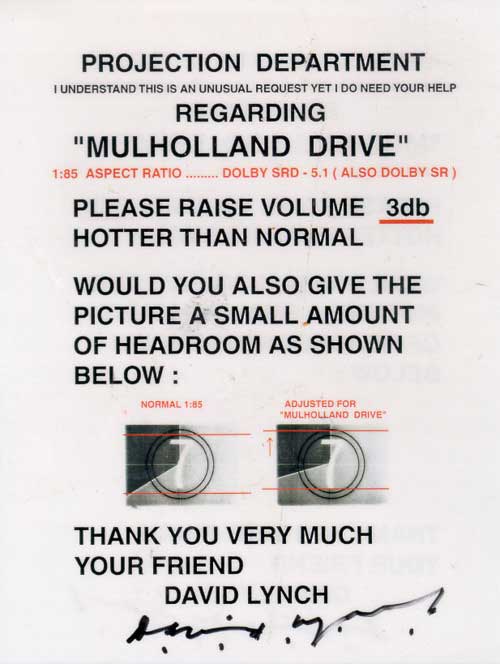
This is normal: Alfred Hitchcock and Kim Novak
Spencer Owen, BERKELEYJanuary 7, 2007 - 35mm/Cerrito Speakeasy
I'm part of the "loved it" half of the microscopic percentage of the world's population that will end up having seen David Lynch's new INLAND EMPIRE. It's a droning behemoth. Yes, Laura Dern wanders slowly through passageways for an endless final 20 minutes of the movie (uh, spoiler), but when I say "droning," I mean the type of sound design that Lynch has been fond of since day one. The first moment of INLAND is a stream of light bursting from a projector in the distance accompanied by a deep, deep bass drone that bursts as well. Leave it to Lynch to associate an illuminating beam emerging from the darkness with the sound of stirring, sudden doom. From there on out, like in all of his other films, the mood is often sonically saturated, especially in the low or low-mid ranges, and the ambience is noted, whether consciously or subconsciously. It was more than cute to discover that Lynch had Mulholland Dr. distributed with a special note instructing the projectionist to (and I paraphrase) turn it the fuck up.

A kindly memo from Eagle Scout Lynch
Today I saw Vertigo for the first time at a beautiful theater in El Cerrito, CA called the Cerrito Speakeasy; if you're in the area, do check their schedule, and if something appeals to you, you can grab a healthy dinner and some alcohol while watching the film. I loved the movie, and I was particularly struck by Bernard Hermann's score. His music had always worked for me in other Hitchcock films (and the shower scene is another topic altogether, but you all can just go ahead and stew on that if you must), but never like this. Tonight, the score's effects followed me outside of the theater. It's rare to hear film music so uniquely orchestrated and so conceptually sound that I'm actually glad they went and blanketed the whole movie with it.
The score for Vertigo was put together precisely in a manner that David Lynch has noticed and run with: an unusual, visceral ambience that enhances and deepens the mood that already exists, something that is brought out of the material rather than pasted on top. The difference is that Lynch scored INLAND with rock 'n' roll (pre-existing and of his own creation), musique concrete, and the atonal works of Krzysztof Penderecki; Hitchcock & Hermann, on the other hand, did all their effects with a classical orchestra and without resorting to pure modernism or atonality. Two good ways of doing it, but it is good to be reminded that there are two ways.
I would go deeper into analysis, but I haven't gotten a hold of the soundtrack recording yet, so it would be a lot of remembrance from my recent first exposure, and I'm not sure how well I trust that for getting details right. But I do recall noticing ... isn't it wonderful how, in this first act, with all these scenes of no dialogue, the score actually does the talking, and I'm glad for it? And isn't it interesting how here, in the second half, the music is much more bittersweet and romantic (though far from traditionally so), whereas in the first half it was truly ... eerie, and unnerving? And the opening credits theme ... so gorgeously slippery, the way the arpeggios are really just not in time with each other, with accents marking ... what rhythm exactly? I could go on. How rare!
There are two moments, though, that Hermann can't take credit for (at least I don't think so). In the movie's first scene, Scotty's hanging out with Midge and -- I have to pause right here to call him a fool for not making it work with Midge, because she was way more appealing and grounded than that crazy Madeleine (not to mention Midge being phenomenally cute), but anyway -- there's some peppy string music playing in the background, if a bit low in the mix. I thought, "Well, this is some delightful background music, seems to serve to brighten the mood, a traditional sunny-day everyday tonal element, kicking off the action '50s-style..." Then one of them, I don't recall who, gets up and takes the needle off a record. This turns out to be some kind of foreshadowing for a moment in which (okay, a real spoiler) Scotty's in a hospital, acting like a near-vegetable, and Midge, in her final appearance, puts on a Mozart record, saying that she's been told Mozart should do the trick. When he doesn't respond, she takes it as a sign that she should turn it off. Just as Bernard Hermann brings out the sensations already present, lying in wait to be enhanced, Mozart won't bring Scotty out of his funk, because there's no Mozart -- or Midge -- inside him.


3 comments:
My friend, David Cohen, remarked offline re: Bernard Herrmann, that he was either a proto-Minimalist or the first real Minimalist, setting the stage for Reich, Riley, Glass and La Monte Young. You can hear it in the short threaded repetitions that are the signature of Herrmann's work, on Vertigo, North by Northwest, and elsewhere.
there is surely a lot of linkin between vertigo and lynch movies in general and inland empire in particular.
when scotty follows madeleine in the small alley , she enters the back of the flower shop, that scene, in example, is quoted in inland empire when laura dern enters the black door with the white chalk mark on it.
the same atmosphere of decay and suspence is perceived inside. genius.
Post a Comment